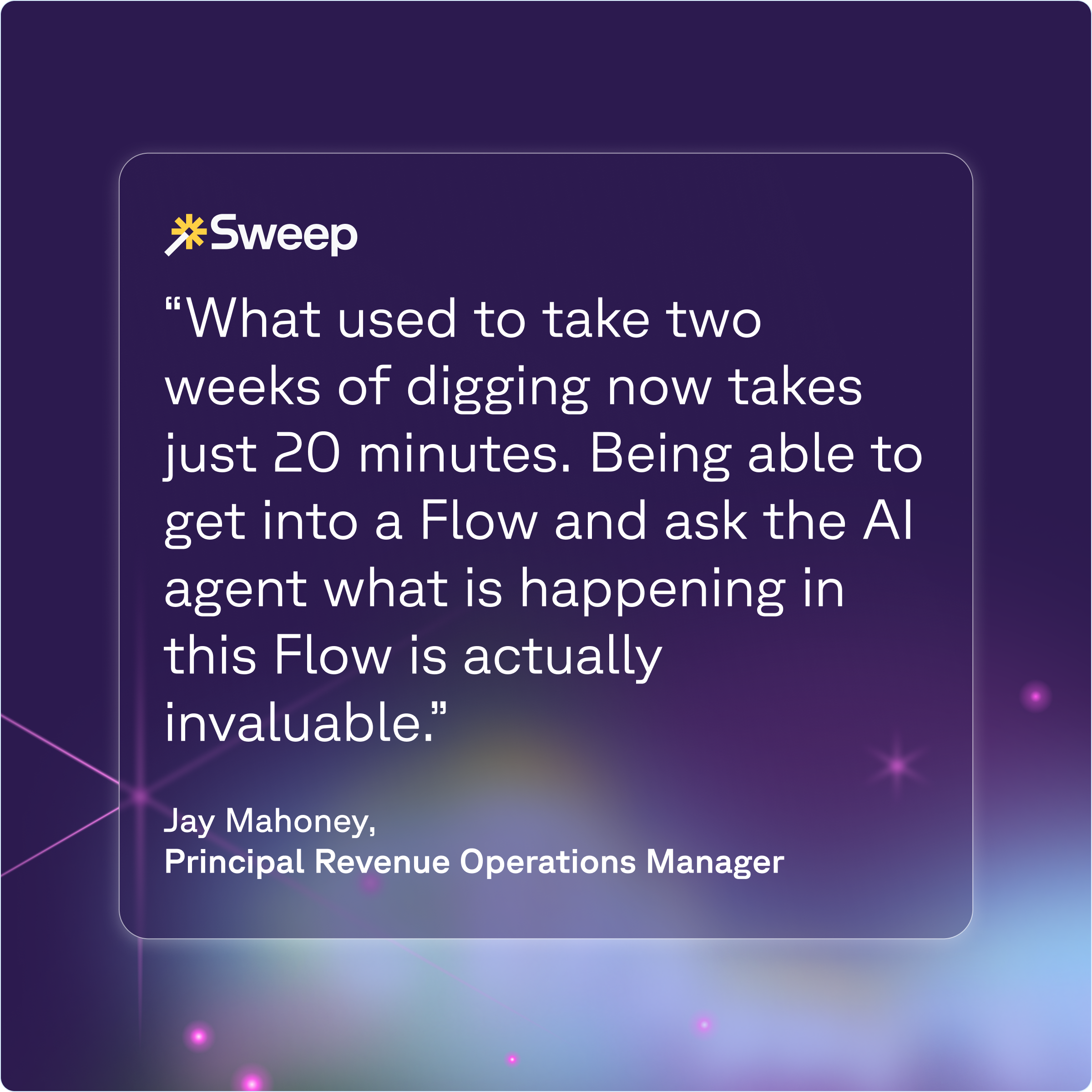Inheriting an existing Salesforce instance is a challenge. But inheriting one that was built over 16 years ago can be overwhelming. The Revenue Operations team at Deputy needed more than just a strategy: they needed clarity. They used Sweep to improve visibility, uncover dependencies and ultimately transform a legacy Salesforce environment into the functioning CRM that the business needed to scale. To know what to fix (and where to start) they relied upon automated documentation from Sweep. It gave them the context they needed to confidently clean up, streamline, and build without fear of breaking something buried deep in the org. Plus, they were able to improve data hygiene, launch a brand new sales process, create actionable Slack alerts along the way.
Deputy is a Sydney-based software company that provides an all-in-one workforce management solution for employee scheduling, timesheets, tasking, and communication. Since 2008, over 500 million shifts have been rostered on Deputy, in over 100 countries, and across 245 different industries. Their team is dedicated to making it easier for businesses to hire, schedule staff, manage documents and communications, streamline payroll, and take the admin out of work.
Using AI-powered documentation with a legacy Salesforce configuration
Given that Deputy’s Salesforce had acquired over 16 years of technical debt, Jay Mahoney, Principal Revenue Operations Manager, Eric Portugal Welsh, Global Director of Revenue Operations, and Parbat Luitel, Lead Solutions Architect, knew that they were stepping into a black box of legacy code and outdated processes. “It was originally built by software engineers,” explains Eric. “Everything was hard-coded. It’s taken 4-5 years to get off the full Apex coded system into something that’s more manageable.”
Without the right tools, understanding what was happening would’ve taken months of manual auditing. But with Sweep’s AI-powered documentation, the team was able to instantly surface hundreds of Flows, thousands of custom fields, and over 300,000 records, mapping every dependency and automation across the org.
“The documentation feature along with AI is a game-changer,” says Parbat. “It has helped me many times in figuring out our legacy processes and automations sitting within Salesforce.

“What used to take two weeks of digging now takes just 20 minutes,“ says Jay. “Being able to get into a Flow and ask the AI agent what is happening in this Flow is actually invaluable.”
That visibility translated into speed: the team was able to troubleshoot issues sent by users in a fraction of the time. “Sweep makes troubleshooting issues a lot simpler because you can just go into the documentation, find the fields that are being affected, and see all the processes, flows and any code that’s touching an issue and resolve it 3x faster,” says Eric.
The result was dozens of hours saved per month, a lighter backlog for the systems team, and faster fixes for users, all while untangling years of technical debt and laying the foundation for scalable growth. “If I have a question, I don't need to go to the business systems team,” says Eric. “I can just answer it myself.”

Improving routing efficiency and accuracy
For Deputy, it’s important that every new lead is routed based on company size. By implementing Sweep, the team has confidence that every new lead is immediately sent to the appropriate team. Recently, they made an update to the threshold number and were able to deploy the entire change in less than 5 minutes. “We can deploy changes to our Salesforce 3x faster than before,” says Eric.
“It’s super easy with Sweep - we can just build a routing rule around the logic we need instead of having to navigate the back end of Salesforce,” says Jay. “Instead of taking weeks, this will take a day or two and will be a big win for our company.”
Parbat also attests to the seamless experience of Sweep’s routing tools. “It’s easy to translate distributing rules into Sweep logic,” he says. “Having the sandbox environment is always helpful in order to ensure that the outcome of the tests are what we expected.”
Real-time Slack alerts to drive action
The team was also working on optimizing their sales process, specifically in terms of tracking how long an opportunity should stay categorized as an opportunity before it became stale. Instead of monitoring this manually, the Deputy team used Sweep to create custom Slack alerts that triggered messages to the team based on pre-determined logic.
“In 30 minutes, I built 15 different types of notifications - 5 for each of our regions - and tailored the messaging specifically for the managers that needed them built,” says Eric “It was awesome, so easy.”
The Slack alerts helped support their data hygiene efforts, without requiring an additional manual lift from the team. “Nobody has to be monitoring a hygiene report – it’s just sending a message,” says Jay.
Increasing visibility for existing and new hires
Too often, both business and systems teams using Salesforce are feeling a lack of transparency within the platform. Oftentimes, RevOps uses tools like LucidChart to manually illustrate an existing process to demonstrate what’s happening to other members of the team. But with Sweep’s visual platform, Jay discovered he could easily create a collaborative visual without the manual work. “It’s very clean with Sweep: you can click in to get more detail where you can’t necessarily do that with Lucid,” says Jay. “Being able to pull up a visual process when I’m having a conversation with stakeholders is really valuable.”
Salesforce is not known for its inherent collaborative abilities, but with Sweep, both Jay and Eric were able to bring RevOps and their cross functional partners together. “Sweep solved a real technical problem for systems teams by providing documentation, ease of use, the ability to collaborate globally on a single process, which you can’t do on a competing platform like a LeanData,” says Eric. “We're a global team and most people don’t work in the same time zone.”
The visual element is also incredibly useful for new hires. The Deputy team is looking to bring on a new Salesforce architect in the coming months. “They’ll be able to learn the entire system using Sweep’s documentation,” says Eric.
Maintaining operational agility
As the Deputy team looks towards what’s next, they feel confident knowing that they have a comprehensive view of everything that’s been built, and what needs to be built moving forward. Plus, they feel energized by the fact that they can make the necessary changes with speed and accuracy. “I don’t know if you can get much faster than the Sweep process builders,” says Eric.
And they feel confident knowing that Sweep has their back. “The product agility, support and assurances from the Sweep team is unmatched,” says Parbat.
If you want to learn more about how Sweep can support your new, existing, or legacy Salesforce configuration, book a demo with one of our team members today.

